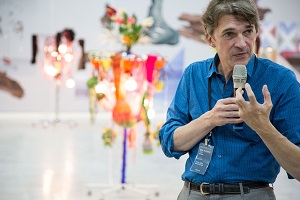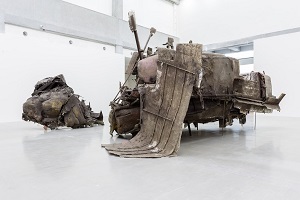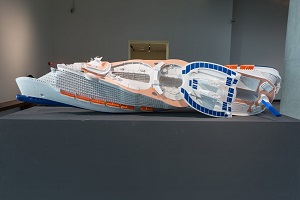Taipei Biennial explores human effects on Earth’s ecosystems
By Yali Chen The must-see show curated by French scholar and art theorist Nicolas Bourriaud presents a wide variety of contemporary artworks by a total of 52 participating artists and teams from throughout the globe. Bourriaud has been well-known for his book Relational Aesthetics, in which he attempted to renew a series of approaches toward contemporary art in the 1990s by getting as close as possible to the artists’ works and by revealing the principles that structure their thoughts: an aesthetic of the inter-human, of the encounter, of proximity, and of resisting social formatting. At the biennial exhibition in Taipei, he expands on his theory of relational aesthetics, examining how contemporary art addresses the new relationship among human beings, animals, plants, machines, products, and objects. Over the past few years, such ideas have become a hot topic among global contemporary artists, but they are little known in Taiwan’s fine art community, says Lin Chung-hsien, the International and Public Relations Officer for the Taipei-based TFAM. He adds that the showcase aims to help local artists and viewers broaden their horizons. The exhibition contains works by 52 artists from every populated continent except Australia. Few of them are famous, but some – Laure Prouvost, who won the 2013 Turner Prize for her piece Wantee (2013), Korean artist Haegue Yang, Belgian Peter Buggenhout, Taiwan’s Peng Hung-chih – are reasonably well known in international art circles. Born in 1978 in Lille, France, Laure Prouvost lives and works in London. She has screened work in film festivals internationally and won the Principal Prize in both the 56th and 57th International Short Film Festival Oberhausen. The mood of the film gradually becomes darker and more unsettling, though nothing is stated directly. The growing intensity of the film is reinforced by the oppressive rhythm of a drum that accompanies snatches of music and speech. The pace of the video tests the limits of perception and makes it hard to take in every image and comment. Repeated viewing subtly shifts what is understood each time, as Prouvost highlights the slipperiness of meaning and notions of reality. Haegue Yang is a Korean artist based in Berlin and Seoul. She is best known for using a wide repertoire of ordinary household objects and materials such as venetian blinds, theatrical and decorative lights, infrared heaters, scent emitters, and fans to create visually abstract sculptures and installations. Since 2006 Yang has been creating light sculptures. Drawing inspiration from medicine men, dollar stores, séances, land art and ballet, she created her work Warrior Believer Lover in 2011. It consists of thirty-three anthropomorphic light sculptures that can be further distinguished into groups, couples and individuals, including The sculptures in Warrior Believer Lover also refer to a multiplicity of cultural references from The Rite of Spring – the ballet and orchestral concert work written by Russian composer-conductor Igor Stravinsky in 1913. Peter Buggenhout is a 50-year-old Belgian artist who hasn’t had a lot of exposure in Taiwan. The three sculptures Nos. 35, 63 and 64 from his The Blind Leading the Blind series now go on display at the Taipei Fine Arts Museum. Buggenhout’s works from The Blind Leading the Blind series are literally heaps of junk – twisted sheets of corrugated steel, metal rods, chassis, tarps and foam rubber – covered in copious amounts of dust. At first glance, they look like readymade objects, rubble found in the aftermath of a building site, an archaeological dig, or at the scene of a cataclysm: an earthquake, explosion or other force of violent destruction. Beneath the constructions’ formal complexity, however, lies a carefully developed internal logic. By covering many of his sculptures with dust, Buggenhout tries to neutralize any symbolic value. In his opinion, dust is a material without meaning, consisting only of leftovers. And yet it can transform objects by accentuating form, while color and material fade to the background. He makes small compositions on his monumental, freestanding installations. Taiwanese artist Peng Hung-chih specializes in the visual media such as installations, films, painting, and sculpture. He always incorporates some elements of art, religion and humanity into the theme of his creations. Peng’s new work, The Deluge – Noah’s Ark (2014), is a twisted boat invoking the disasters of climate change. He uses this piece to show the impotence of human beings in the face of uncontrollable catastrophic challenges. The rapid acceleration in the Anthropocene era causes climate change, environmental pollution, and ecological crises. Peng’s creation serves as a metaphor for the collision among Mother Nature, industrialization and globalization. “Taipei Biennial 2014: The Great Acceleration”
STAFF WRITER The 2014 Taipei Biennial, titled The Great Acceleration: Art in the Anthropocene, has kicked off at the Taipei Fine Arts Museum (TFAM) and will run through January 4, 2015.
The 2014 Taipei Biennial, titled The Great Acceleration: Art in the Anthropocene, has kicked off at the Taipei Fine Arts Museum (TFAM) and will run through January 4, 2015.The French curator also elaborates on the concept of the Anthropocene, a geological term coined in the 1980s by ecologist Eugene F. Stoermer to describe the influence of human activities on the Earth’s ecosystems.
 Her work It, Heat, Hit (2010) is a self-described “3D film without the 3D” that was shown at Tate Britain in the same year. It constructs and propels an inferred story through a fast-moving sequence of written commentary and excerpts of everyday incidents and pictures that have been filmed by the artist. Innocent and pleasing images, such as a swimming frog or snowy street scene, are followed by statements of love and implied violence. These are inter-cut with strange, disconnected images, such as close-ups of flowers, body parts or food.
Her work It, Heat, Hit (2010) is a self-described “3D film without the 3D” that was shown at Tate Britain in the same year. It constructs and propels an inferred story through a fast-moving sequence of written commentary and excerpts of everyday incidents and pictures that have been filmed by the artist. Innocent and pleasing images, such as a swimming frog or snowy street scene, are followed by statements of love and implied violence. These are inter-cut with strange, disconnected images, such as close-ups of flowers, body parts or food. the group of six of Medicine Men and Female Natives. Each light sculpture is a composition of light bulbs, electric cords, metal clothing racks, handicrafts, and readymade materials such as artificial plants and wigs around a commercial metal stand.
the group of six of Medicine Men and Female Natives. Each light sculpture is a composition of light bulbs, electric cords, metal clothing racks, handicrafts, and readymade materials such as artificial plants and wigs around a commercial metal stand.
Telephone: 02-2595-7656
Address: No.181, Sec. 3, Zhongshan N. Rd., Zhongshan Dist., Taipei City
Hours: 9:30am – 5:30pm Tuesdays to Sundays, 9:30am – 8:30pm Saturdays, closed Mondays
Tickets: NT$30 (full rate), NT$15 (with discount)
Getting there: Take the MRT Danshui (Red) Line to Yuanshan Station and take Exit 1. Walk about 10 minutes.
Participating artists: Harold Ancart of Belgium, Charles Avery of the U.K., Gilles Barbier of France, Alisa Baremboym of the U.S., Neïl Beloufa of Algeria/France, Peter Buggenhout of Belgium, Roberto Cabot of Brazil, Patrick Van Caeckenbergh of Belgium, Chang En-man of Taiwan, Ian Cheng of the U.S., Chou Ching-hui of Taiwan, Chu Chun-teng of Taiwan, Shezad Dawood of the U.K., David Douard of France, Camille Henrot of France, Roger Hiorns of the U.K., Hu Xiao-yuan of China, Huang Po-chih of Taiwan, Joan Jonas of the U.S., Hudinilson Jr. of Brazil, Tetsumi Kudo of Japan, Surasi Kusolwong of Thailand, An-My Lê of Vietnam/the U.S., Lin Kuo-wei of Taiwan, Maria Loboda of Germany, Jonah Freeman & Justin Lowe of the U.S., Luo Jr-shin of Taiwan, Tala Madani of Iran/the U.S., Abu-Bakarr Mansaray of Sierra Leone/ the Netherlands, Josephine Meckseper of Germany, Nathaniel Mellors of the U.K., Marlie Mul of the Netherlands, Henrik Olesen of Denmark, OPAVIVARÁ! of Brazil, Ola Pehrson of Sweden, Peng Hung-chih of Taiwan, Laure Prouvost of France/the U.K., Matheus Rocha Pitta of Brazil, Rachel Rose of the U.S., Pamela Rosenkranz of Switzerland, Mika Rottenberg of Argentina, Sterling Ruby of the U.S., Timur Si-Qin of Germany, Shimabuku of Japan, Peter Stämpfli of Switzerland, Nicolás Uriburu of Argentina, Wu Chien-ying of Taiwan, Wu Chuan-lun of Taiwan, Inga Svala Thórsdóttir & Wu Shanzhuan of China/Iceland, Wang Yu-chen of Taiwan/the U.K., Haegue Yang of South Korea, and Anicka Yi of the U.S.

![Taiwan.gov.tw [ open a new window]](/images/egov.png)
